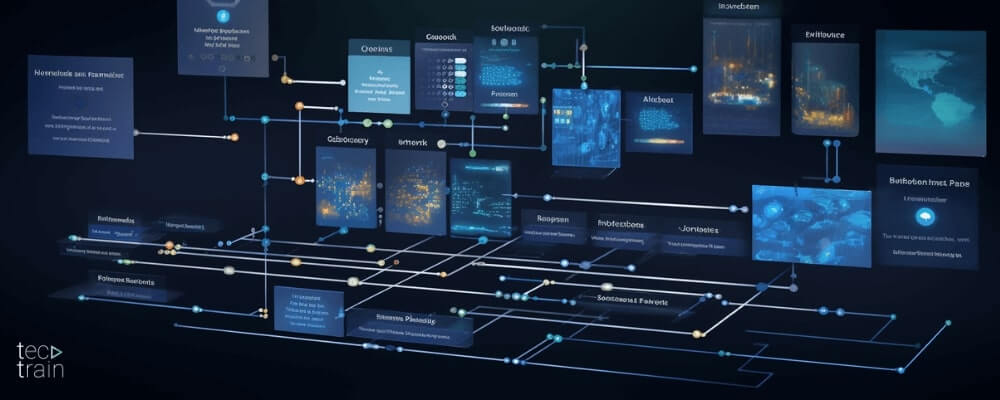Introduction to the C4 model as a solution
Understanding how software is built can take time and effort. Think of it like trying to understand a city without a map. Using tools to visualize or "draw" software's structure helps everyone, from developers to managers, understand how everything fits together.
One of the best tools for this is the C4 model. It's like a multi-layered map, showing everything from the big picture to the tiny details. In this blog, we'll dive into the C4 model and see how it makes understanding software easier for everyone.
Understanding the Basics of Software Architecture Visualization
Software systems can be like puzzles with many pieces. Trying to show or explain how all these pieces fit together can be tough. It's not just about the individual parts, but also about how they connect and work with each other. When we try to represent these systems without a clear method, it can lead to confusion and misunderstandings, making it hard for both creators and users to grasp the system's full picture.

That's where the importance of a structured approach comes in. Just like following a recipe when cooking, having a set method to visualize software helps in laying out each part clearly. This structure ensures that everyone, whether they're building the software or using it, can easily understand its design and function. It's like having a well-organized toolbox where every tool has its place, making tasks smoother and more efficient.
Featured Resource
Software Architecture: The Ultimate Guide
What is the C4 Model for Software Architecture?
The C4 model is a way to visualize software architecture. Think of it as a map that shows different levels of a software system. It was created to help software teams describe and understand how their software is built and how the different parts fit together. The name "C4" comes from its four layers, which help break down the complexity of software into more manageable pieces.
Now, let's talk about these four layers or the "4Cs".
- First, there's "Context", which gives a big-picture view of the software, showing how it interacts with other systems and users.
- Next is "Containers", which dives a bit deeper, showing the major parts of the software and how they connect.
- "Components" goes even deeper, detailing the inner parts of those major sections.
- Finally, "Code" gets into the finest details, showing the actual programming behind everything. Together, these layers provide a clear and structured view of any software system.
Benefits of Using the C4 Model Software Architecture
One of the standout benefits of the C4 model is how it brings clarity to software design. Instead of seeing a jumbled mess, you get a clear picture at different levels. It's like looking at a city from a plane, then from a building's rooftop, then from the street.
Each view gives you different details, from the overall layout to specific street names. Similarly, the C4 model lets you see the big picture of a software system and then zoom in to understand the smaller parts.
Another great thing about the C4 model is how it helps people talk about software. Whether it's a developer explaining to another developer, or a project manager discussing with a client, the C4 model provides a common language. Everyone can refer to the same clear diagrams, making conversations more productive and reducing misunderstandings.
Lastly, documenting software can often feel like a chore. But with the C4 model, this process becomes much smoother. Since the model already breaks down the software into clear layers and parts, turning that into documentation is more straightforward. It's like having an outline ready before you start writing a report, making the task faster and more organized.
Diving Deeper into the 4Cs

Context in 4C Software Architecture
The Context level in the C4 software architecture acts as the bird's-eye view of a digital landscape. It offers a broad perspective, highlighting how the software interacts with other systems, services, and users within the vast digital ecosystem. This foundational layer of the software architecture C4 approach ensures everyone comprehends the software's primary role and its interactions, setting the stage for deeper exploration.
Containers in the C4 Model for Software Architecture
Zooming in from the overarching context, we encounter the Containers level of the C4 model for software architecture. This segment is akin to focusing on specific neighborhoods within a city's map.
It provides insights into the major sections of the software and the high-level technology choices, such as whether a segment is a web application or a database. The Containers level is pivotal in the C4 software architecture, guiding broad technological decisions and frameworks.
Components in the C4 Software Architecture
Delving deeper into the C4 model for software architecture, the Components level emerges. Here, individual elements or "buildings" within those software "neighborhoods" are in focus. This intricate layer breaks down the broader sections, shedding light on the interactions and relationships between different software modules. It's a crucial aspect of the software architecture C4 approach, offering developers a detailed roadmap for their building process.
Code: The Heart of the C4 Software Architecture
The Code level, the most granular layer in the C4 software architecture, is where the rubber meets the road. It's akin to inspecting individual rooms within a building, focusing on the actual programming lines that bring the software to life.
This foundational layer ensures that the broader visions from the other layers materialize into a functional software system, cementing the C4 model for software architecture as a holistic and comprehensive approach.
Comparing C4 Software Architecture with Other Visualization Methods
When exploring the realm of software architecture visualization, various methods come to the fore. However, the C4 software architecture has carved a niche for itself, standing out in several ways. Unlike many traditional visualization techniques that either dive too deep too quickly or remain too high-level, the C4 model offers a balanced, multi-layered approach. It systematically breaks down the architecture from a broad context to the nitty-gritty details of code, ensuring clarity at every stage.
The benefits of the C4 model are numerous. Its structured layers make it adaptable to both small-scale projects and large, complex systems. This adaptability ensures that all stakeholders, from developers to business analysts, can find common ground in understanding and discussing the system.
However, like all methods, the C4 software architecture isn't without potential drawbacks. For teams or individuals accustomed to other visualization techniques, there might be an initial learning curve. Additionally, for very small projects, the multi-layered approach might feel excessive. Yet, when weighed against its advantages, especially in fostering clear communication and understanding, the C4 model for software architecture often emerges as a preferred choice for many.
Real-world Examples of C4 Software Architecture Implementation
The theoretical aspects of the C4 software architecture model are compelling, but its real value shines through in practical applications. Let's delve into a couple of real-world examples that showcase the model's effectiveness:
E-Commerce Platform
A leading e-commerce company wanted to revamp its platform to cater to a growing user base and integrate new features. Using the C4 model, they started with the Context layer, identifying interactions between users, vendors, payment gateways, and other external systems. Moving to the Containers layer, they mapped out their web application, mobile app, backend processing systems, and databases.
The Components layer helped them detail the interactions between various modules like product search, cart management, and payment processing. Finally, the Code layer ensured that developers had clear guidelines for implementing each module. The result? A seamlessly upgraded platform with improved user experience and efficient backend operations.

Healthcare Management System
A healthcare provider aimed to integrate various services, from patient records to appointment scheduling, into a unified system. With the C4 software architecture model, they began by defining the Context and understanding interactions between patients, doctors, administrative staff, and external systems like insurance providers.
The Containers layer helped visualize the main systems: patient portal, administrative dashboard, and database. Diving into Components, they detailed modules like patient data management, appointment scheduling, and billing. The Code layer provided the foundation for building these modules. The outcome was a holistic healthcare management system that streamlined operations and enhanced patient care.
These examples underscore the C4 model's versatility and its ability to bring clarity and structure to diverse projects, ensuring that the end product aligns with the envisioned architecture.
Featured Resource
Software Architecture in Practice: Real-World Applications
Conclusion
Navigating the intricate world of software architecture can often feel like traversing a maze. However, tools like the C4 model for software architecture act as guiding lights, illuminating the path.
As we've explored, the C4 approach offers a structured, layered perspective, ensuring that every stakeholder, from developers to business analysts, gains a clear understanding of the system at hand. Its benefits, from fostering clear communication to streamlining documentation, make it an invaluable asset in the software development process.
For those who haven't yet dipped their toes into the C4 waters, there's no time like the present. Whether you're looking to revamp an existing system or kickstart a new project, the C4 approach promises clarity and coherence. And for those familiar with it, continuous exploration and learning can only enhance its application.
And for those eager to delve deeper, consider checking out related resources or courses. A deeper understanding of the C4 model or other architectural approaches can only elevate your software design journey.








